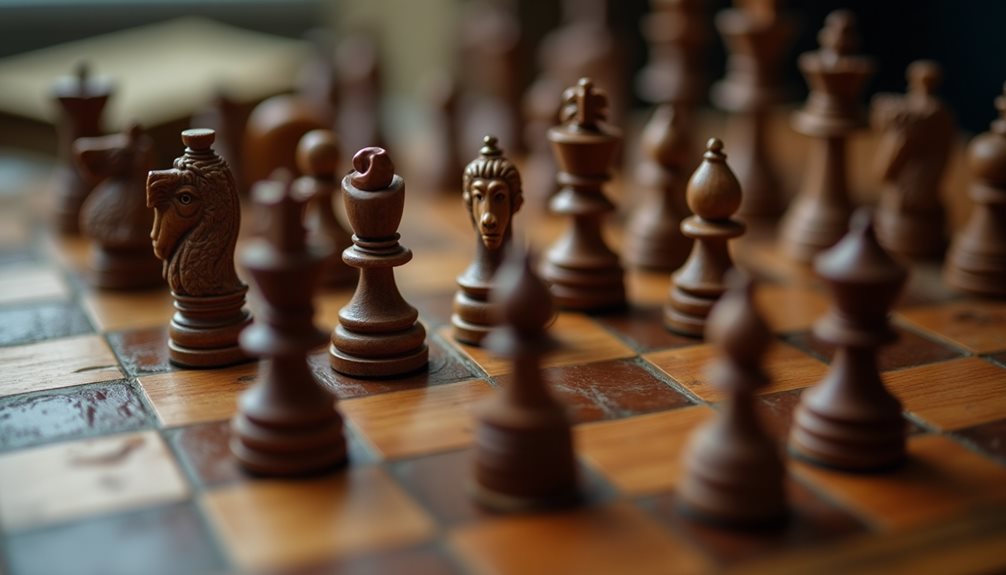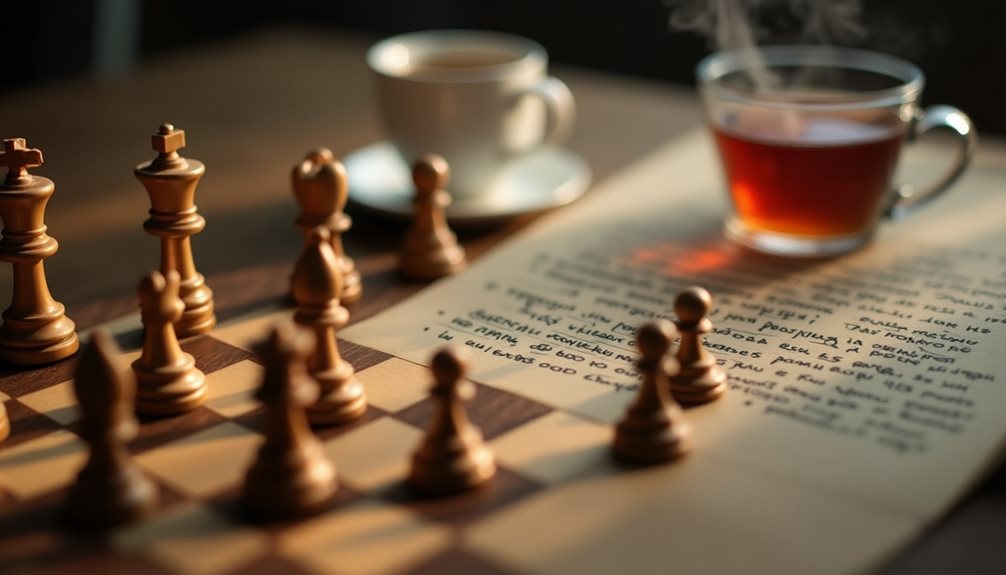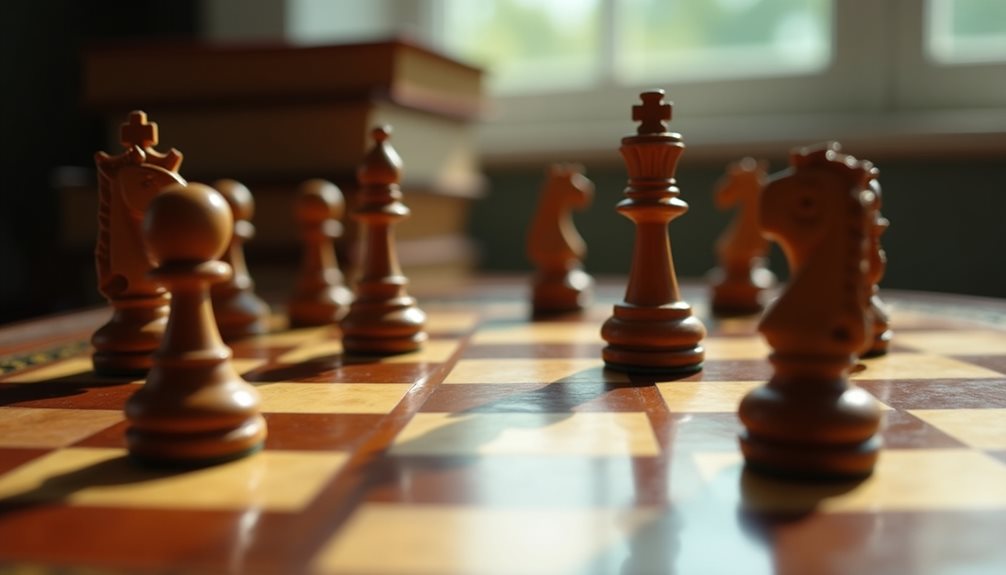Table of Contents
ToggleThe Origins of Russian Chess Terminology

Although the game of chess has roots that extend far beyond Russia, the unique terminology that has developed within the country reflects its rich cultural and historical context.
The origins of Russian chess terminology are deeply intertwined with historical influences, including the interplay of Slavic languages and the importation of chess from Persia and Europe. As the game evolved in Russia, so did its language, showcasing a fascinating linguistic evolution.
Terms like “шах” (shakh) for check and “мат” (mat) for mate illustrate how language can capture concepts of strategy and competition. This lexicon not only serves as a means of communication but also embodies the spirit of Russian chess culture, revealing layers of meaning shaped by centuries of artistic and intellectual exchange.
Key Terms and Their Strategic Implications
Chess, a game of profound strategy, is steeped in a language that conveys not only rules but also the nuances of tactical thinking.
Key terms such as “pawn structure” and “tactical motifs” highlight the intricate relationship between language and strategy. The concept of pawn structure serves as a foundation, influencing the dynamics of the game; it dictates potential weaknesses and strengths, guiding players in their decisions.
Meanwhile, tactical motifs encapsulate recurring patterns that can turn the tide of a match. Understanding these terms empowers players, enriching their strategic freedom and enhancing their ability to navigate complex positions.
Ultimately, the interplay of vocabulary and strategy deepens the appreciation of chess as a sophisticated intellectual pursuit.
Famous Russian Chess Players and Their Influence on Language
Numerous Russian chess players have profoundly shaped both the game itself and the language associated with it. Their legacies extend beyond the board, influencing terminology and strategic discussions.
- Kasparov’s Legacy: Introduced concepts like “deep calculation” and “dynamic play,” which permeate modern chess discourse.
- Karpov’s Strategy: Emphasized positional play and the notion of “quiet moves,” enriching the tactical vocabulary.
- Tal’s Creativity: Known for his imaginative tactics, he popularized terms related to daring sacrifices.
- Petrosian’s Defense: His unique defensive style birthed terminology surrounding prophylactic moves.
Famous Russian chess players and their influence on language:
| Chess Player | Lifespan | Key Achievements | Influence on Language | Example Terms/Expressions |
|---|---|---|---|---|
| Garry Kasparov | 1963 – present | World Chess Champion (1985–2000) | Popularized chess terminology worldwide; known for strategic thinking phrases used in politics and business | “Kasparov’s Gambit,” “Kasparovian strategy” |
| Anatoly Karpov | 1951 – present | World Chess Champion (1975–1985) | His name associated with positional, patient play; terms like “Karpovian style” in discussions of gradual strategy | “Karpovian positional play” |
| Mikhail Botvinnik | 1911 – 1995 | World Chess Champion (1948–1963) | Influenced Soviet chess school; “Botvinnik system” in openings; synonymous with scientific chess approach | “Botvinnik system,” “Botvinnik approach” |
| Alexander Alekhine | 1892 – 1946 | World Chess Champion (1927–1935, 1937–1946) | His aggressive style influenced chess vocabulary; “Alekhine’s Defense” opening named after him | “Alekhine’s Defense” |
| Vladimir Kramnik | 1975 – present | World Chess Champion (2000–2007) | Known for deep strategic concepts; “Kramnik Variation” in openings named after him | “Kramnik Variation” |
These players not only excelled in their craft but also left an indelible mark on chess language, reflecting the evolution of strategic thought in the game.
Cultural Significance of Chess in Russian Society
The intricate relationship between chess and Russian culture underscores the game’s profound significance within society.
Chess traditions in Russia are deeply embedded in the nation’s identity, often viewed as a metaphor for strategic thinking and intellectual prowess. The game serves as a cultural symbolism of resilience and adaptability, traits that resonate with the historical narrative of the Russian people.
Chess gatherings, from local parks to grand tournaments, foster community and encourage intellectual discourse, reinforcing the idea that chess is not merely a game but an essential element of social fabric.
This cultural significance extends beyond leisure, reflecting a collective aspiration for excellence and a celebration of mental agility, which continues to inspire generations within Russia and beyond.
Chess holds a special place in Russian culture, symbolizing more than just a game. It reflects deep intellectual traditions and a collective spirit that has shaped the nation’s identity through history.
Chess as a Symbol of Intellectual Strength and Strategy
In Russia, chess is often seen as a representation of strategic thinking (стратегическое мышление) and intellectual prowess (интеллектуальное мастерство). The game embodies qualities such as patience, foresight, and adaptability—traits highly valued in Russian society. Historically, Russians have admired chess players as thinkers and problem solvers, which aligns with the country’s emphasis on education and mental discipline.
Example: The famous Russian grandmaster Garry Kasparov is celebrated not only for his chess achievements but also for his sharp analytical mind and political activism.
Chess in Everyday Life and Community
Chess is not confined to elite circles. It is popular in local parks (парки), community centers, and schools across Russia. Social gatherings around chess boards serve as a way for people of all ages to connect, share ideas, and challenge each other intellectually.
- In many Russian cities, you can find elderly men playing chess in parks like Gorky Park (Парк Горького) in Moscow.
- Schools encourage students to learn chess early on, reinforcing skills like critical thinking and patience.
Chess as a Reflection of Russian Resilience
Chess is often linked with resilience and adaptability, mirroring the historical trials Russia has faced. The ability to anticipate an opponent’s moves and respond effectively in chess parallels how Russians have navigated complex political and social changes over centuries.
Cultural Events and National Pride
Russia hosts major international chess tournaments, such as the Candidates Tournament (Турнир претендентов) and the World Chess Championship (Чемпионат мира по шахматам). These events attract global attention and showcase Russia’s continuing dominance and passion for the game.
Related Russian Terms for English Speakers Learning Russian About Chess
| Cyrillic | English Phonetic | English Definition |
|---|---|---|
| шахматы | shakhmaty | chess |
| шахматист | shakhmatist | chess player |
| партия | partiya | game or match (in chess context) |
| ферзь | ferz’ | queen (chess piece) |
| ладья | lad’ya | rook (chess piece) |
| пешка | peshka | pawn |
| король | korol’ | king (chess piece) |
| шах | shakh | check (chess term) |
| мат | mat | checkmate |
| ход | khod | move (in chess) |
| стратегия | strategiya | strategy |
| тактика | taktika | tactics |
![]()
Chess serves as a bridge between generations in Russia, linking history, culture, and education. For English speakers learning Russian, exploring chess-related vocabulary offers insight into this important cultural element while expanding language skills.
Practical Tips for Incorporating Russian Vocabulary Into Your Game

Incorporating Russian vocabulary into the game can enrich the experience for players seeking to deepen their understanding of not only the strategic elements but also the cultural nuances associated with chess.
To effectively integrate this linguistic aspect, players can utilize various methods:
- Engage in vocabulary games that promote active learning.
- Use mnemonic techniques to remember key terms, enhancing recall during matches.
- Practice speaking Russian chess terminology with peers to foster fluency.
- Create flashcards featuring terms and their translations to reinforce learning.
Incorporating Russian vocabulary into your chess game not only improves your language skills but also connects you with the rich cultural history of the game. Russian is a language deeply tied to chess, with many famous players and literature originating from Russia. Below are some expanded tips and examples to help you integrate Russian chess terms into your learning and gameplay effectively.
Example List of Common Russian Chess Terms
| Cyrillic | Phonetic | English Definition |
|---|---|---|
| Шахматная доска | Shakhmatnaya doska | Chessboard |
| Пешка | Peshka | Pawn |
| Ладья | Lad’ya | Rook |
| Конь | Kon’ | Knight |
| Слон | Slon | Bishop |
| Ферзь | Fyerz | Queen |
| Король | Korol’ | King |
| Шах | Shakh | Check |
| Мат | Mat | Checkmate |
| Ход | Khod | Move |
| Игрок | Igrook | Player |
| Партия | Partiya | Game / Match |
| Открытие | Otkrytiye | Opening (chess opening) |
![]()
Practical Examples of Using Russian Vocabulary in Context
- During a game:
- “Я двигаю пешку на е4.” (Ya dvigayu peshku na e4.)
I move the pawn to e4.
- “Я двигаю пешку на е4.” (Ya dvigayu peshku na e4.)
- Discussing strategy:
- “Ладья защищает короля.” (Lad’ya zashchishchayet korolya.)
The rook protects the king.
- “Ладья защищает короля.” (Lad’ya zashchishchayet korolya.)
- Analyzing a position:
- “Конь на поле f3 атакует слона.” (Kon’ na pole f3 atakuyet slona.)
The knight on f3 attacks the bishop.
- “Конь на поле f3 атакует слона.” (Kon’ na pole f3 atakuyet slona.)
Additional Tips for Language Integration
- Watch Russian commentary on chess games: Listening to native speakers discussing chess in Russian helps with natural usage and pronunciation.
- Read simple Russian chess books or articles: Start with beginner-friendly material to gradually increase vocabulary.
- Label your physical chess set: Put small stickers with Russian names on each piece to create constant visual reminders.
By weaving these methods into your study routine, you’ll not only improve your chess skills but also gain a richer understanding of the language and culture behind this timeless game. This dual learning approach makes your experience more rewarding and engaging. These strategies not only bolster language skills but also provide players with a unique perspective on chess, thereby enhancing their overall gameplay experience.
Embracing this vocabulary opens doors to deeper appreciation and understanding of the game’s rich heritage.



